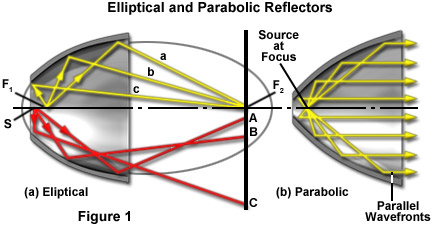Aftermarket manufacturers are playing an increasingly important role in the development of stand-alone light sources for use in fluorescence microscopy. Initially these auxiliary devices consisted mainly of fiber optic illuminators suitable for use with dissecting microscopes, but more recently, advanced light sources suitable for use in high-performance fluorescence microscopy have become available. In addition to coupling advanced metal halide arc lamps with elliptical collection mirrors and high-speed filter wheels for rapidly shifting the output wavelength, these sources also provide fiber optics or liquid light guides for coupling the output to the microscope optical train. This interactive tutorial explores how careful positioning of the arc with respect to elliptical reflector focal points is critical to the formation of a focused beam at the input of a liquid light guide.
The tutorial initializes with the image of a metal halide arc lamp positioned at the first focal point within an elliptical reflector along with a projection of the focused spot. To operate the tutorial, use the Light Source Shift slider to translate the arc along the optical axis of the reflector. Note how the light ray traces diverge from focus and the projection becomes more diffuse as the slider is moved back and forth.
Unlike xenon and mercury arc lamps, the metal halide lamps used in microscopy are equipped with elliptical reflectors into which the bulb is embedded at the factory during manufacture. The lamps are designed to generate a concentrated spot of light at a specified distance in front of the reflector (the lamp focal length; see Figure 1(a)). One of the fundamental advantages of pre-assembled reflector lamps (which are manufactured to very close tolerances) is that each time the lamp is replaced, the reflector is also replaced into a fixed position within the lamphouse, thus eliminating the stringent and cumbersome alignment requirements of mercury and xenon arc lamps. The reflectors on metal halide lamps are coated with multiple dichromatic interference filter layers that enable much of the thermal (infrared) radiation to pass through the reflector while the ultraviolet and visible wavelengths are concentrated at the focused spot. This design ensures that an even distribution of luminous intensity and color temperature from the illumination spot is directed into the light guide.

Reflector metal halide lamps targeted for microscopy are usually equipped with elliptically-shaped focusing mirrors, but other versions feature reflectors that form parallel light bundles (see Figure 1(b)). Elliptical reflectors feature a luminous intensity characteristic that varies significantly as a function of distance from the front focal plane, but many of these collectors can gather up to 85 percent of the total emitted light. Unfortunately, however, the projected ray bundle can be disrupted by a dark central spot where the wavefronts are obscured by the end of the plasma tube. Focal lengths for high-performance elliptically shaped collector lamps range from approximately 24 to 45 millimeters (measured from the front edge of the reflector). Parabolic (Figure 1(b)) and spherical reflectors produce parallel wavefronts that enable the source to be imaged into infinity, and therefore, are not generally useful in external lamphouses that transfer illumination to the microscope through fiber optic cables or liquid light guides. A critical element on reflector lamps is to examine the overall design criteria to ensure that only a minimal amount of radiation (in fact, the least amount possible) is reflected back toward the lamp itself. Improper back-illumination produces excessive quantities of heat in the regions surrounding the tube and stems, a potentially serious artifact that can be significantly detrimental to the physical integrity, performance, and cooling strategy for the lamp.
Contributing Authors
Adam M. Rainey and Michael W. Davidson - National High Magnetic Field Laboratory, 1800 East Paul Dirac Dr., The Florida State University, Tallahassee, Florida, 32310.




